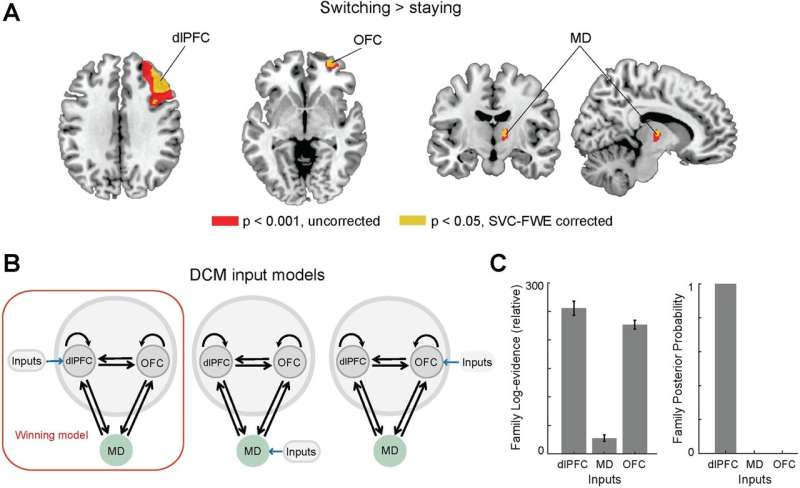by Ruhr-Universitaet-Bochum

Human fMRI confirms the dlPFC, not OFC or MD, receives the driving sensory input. A. Strategy switching (Switching>Staying) entailed significant activity in right dlPFC, right OFC and right MD; here projected on axial, coronal and sagittal MRI brain slices. Brain activations displayed at p < 0.001 (uncorrected, red) and p < 0.05 (whole brain FWE correction, yellow; small-volume correction, blue). B. Models with dlPFC, MD and OFC receiving sensory tactile driving “inputs” respectively. C. Bayesian Model Selection revealed dlPFC, not OFC or MD, as the input region. The left panel shows the average and standard error of log-evidence for all models in the corresponding inputs family (we have 6 models for each input family, see S5 Fig). The sum of the log-evidence over subjects was used to compute the expected model posterior probabilities of each input family which are shown in right panel. (dlPFC–dorsolateral prefrontal cortex; OFC–orbitofrontal cortex; MD–thalamic mediodorsal nucleus). Credit: PLOS Computational Biology (2022). DOI: 10.1371/journal.pcbi.1010500
Researchers have recreated the brain functions of mice and humans using computers. Artificial intelligences could learn from this.
The thalamus has long been considered a brain region primarily responsible for processing sensory stimuli. Recent studies have provided increasing evidence that it constitutes a central switch in cognitive processes. Neuroscience researchers led by Professor Burkhard Pleger in Collaborative Research Center 874 at Ruhr-Universität Bochum and a team from the Massachusetts Institute of Technology (MIT, U.S.) observed learning processes in the brains of mice and humans and modeled them in mathematical models. They showed that the region of the mediodorsal nucleus in the thalamus plays a decisive role in cognitive flexibility. They published their findings in the journal PLOS Computational Biology on September 12, 2022.
A simple learning task
The joint research of the German and U.S. teams began with experimental observations of the brain during simple learning tasks. The German team had observed the brain activity of human test participants using functional magnetic resonance imaging while the test subjects had to feel two different stimuli in different sequences with their fingertips. They were then asked to predict the next stimulus in each case. Depending on how likely it was that one or the other stimulus would occur, this task was either easier or more difficult to learn.
The MIT team had mice complete a very similar learning task, not only observing their brain activity in the process, but later replicating it in the form of a mathematical model. “When we read the relevant paper, we immediately spotted the great similarity between the activation patterns in mice and humans,” says Burkhard Pleger.
Based on the work of their colleagues, the two research teams jointly extended the mathematical mouse model to include the human components. His team and the U.S. team broke new ground with the current study: “Researchers who work with mice and ourselves who work with humans had to develop a common terminology first so that we could work together,” he explains.
Results are interesting for three reasons
When the researchers subsequently applied the mathematical model to the learning task from the experiment, it produced mostly the same results as the test participants. “There was almost 90% correlation, which is very high,” says Pleger.
A characteristic of the mathematical network model is that the region of the mediodorsal nucleus in the thalamus is in constant exchange with regions of the prefrontal cortex. “This proves once again the huge significance of the thalamus for cognitive processes,” says Burkhard Pleger.
“This is of particular interest for three reasons: firstly, because cognitive flexibility is essential for survival. Secondly, because it’s at the center of pathology in a great many psychiatric disorders. And last but not least, because we can mimic things that we can explain by means of mathematical models. Thus, we can draw conclusions about how artificial intelligences might learn.”

Leave a Reply